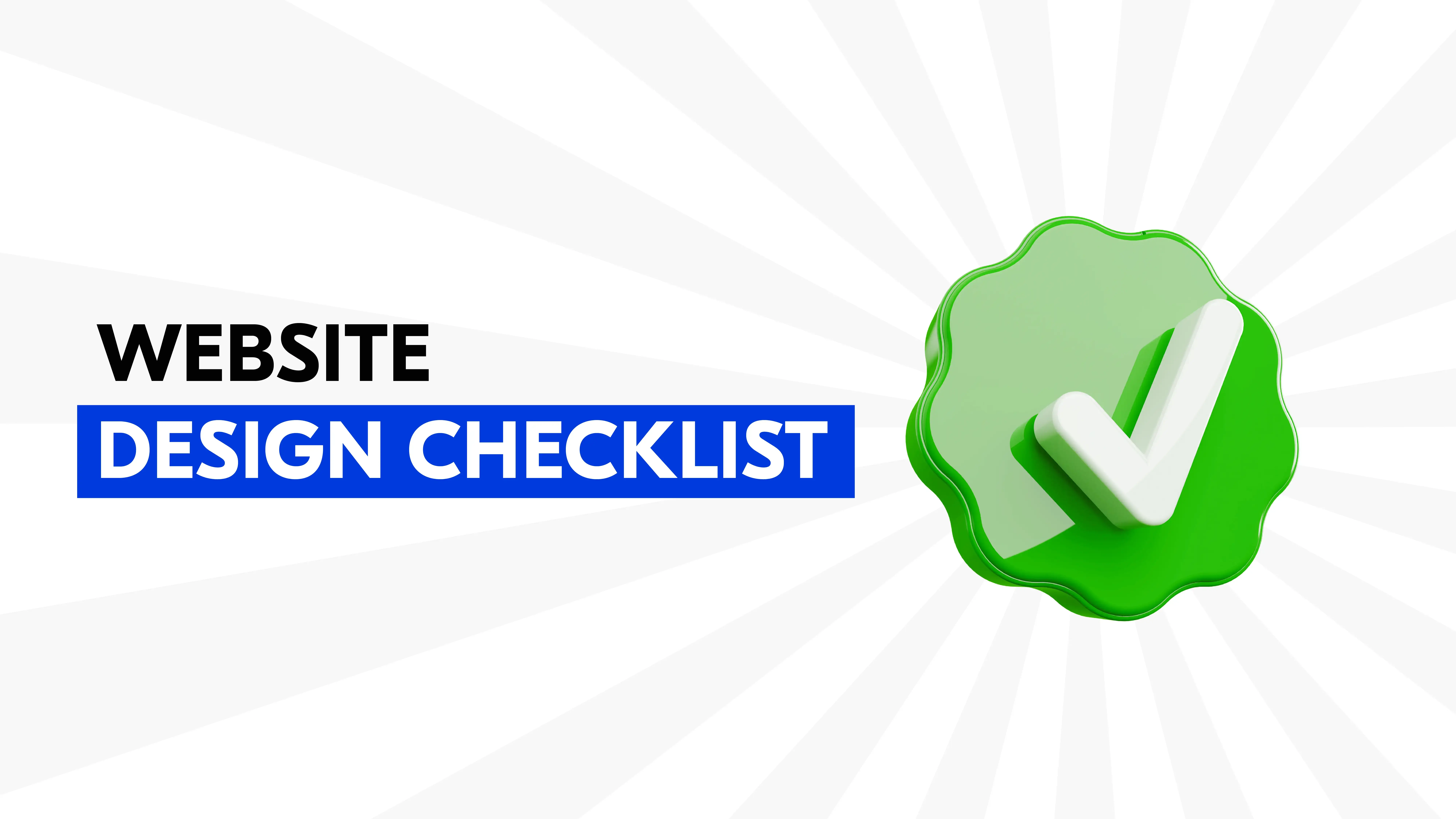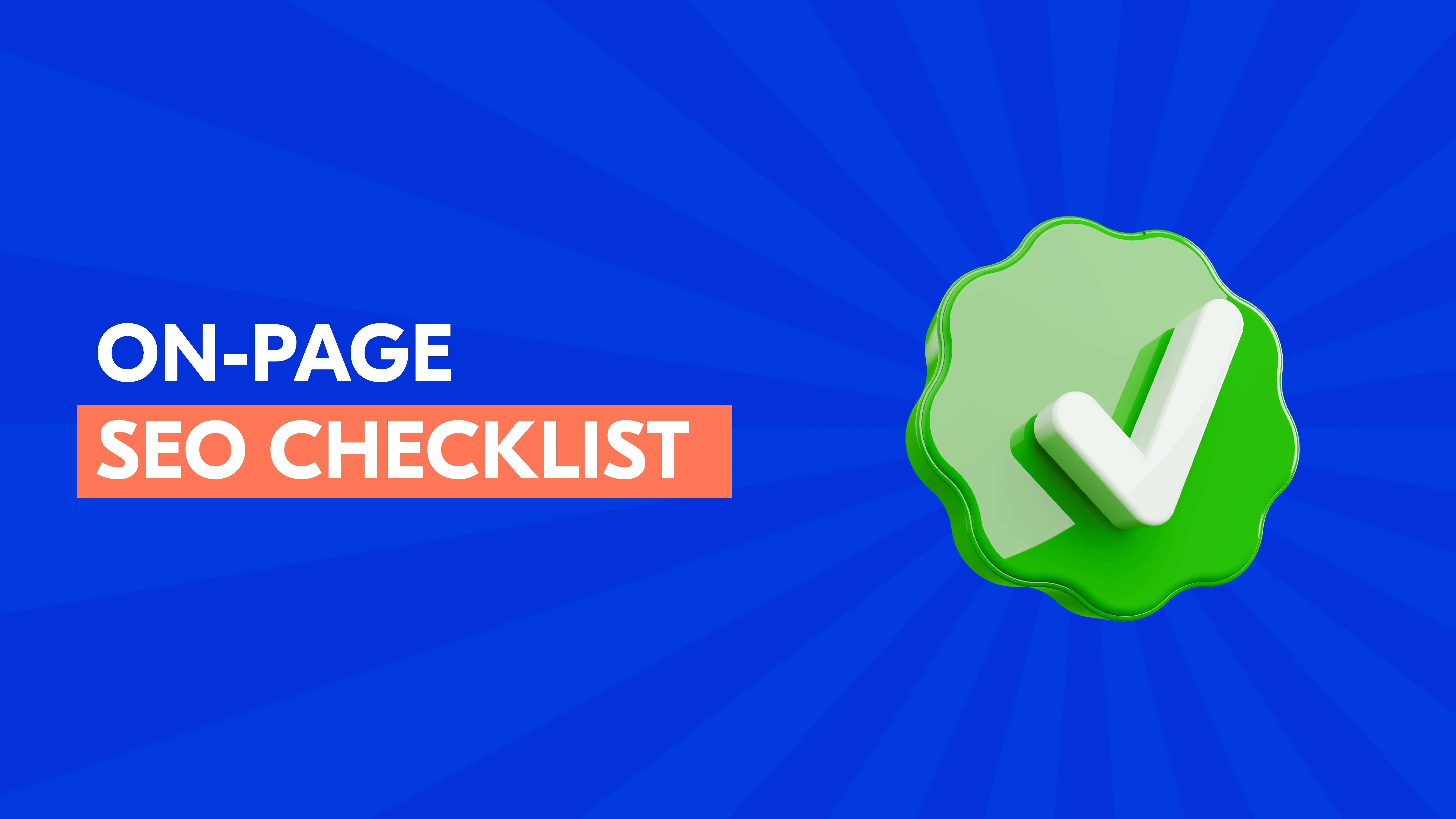The way people search online is changing fast.
Just a couple of years ago, getting your business found online meant showing up on page 1 of Google through traditional SEO.
That’s still important. But today, there’s a new player in town: AI search engines. I am talking about tools like ChatGPT, Google AI Overviews, Microsoft Copilot, and Perplexity. These tools don’t list websites, they give people answers right away without making them click anything.
It’s simple: You type in your query and get an instant answer. So, your goal now is to get these AI tools to mention your business, share your advice, and quote your website in their answers. And to do so, you need AI Search Optimization.
But does this even matter?
Well, if you’re a small business owner trying to build visibility, credibility, and trust, it does. That’s because with AI SEO your website, blog, or business listing can all be featured inside ChatGPT answers, Google AI overviews, and more.
That’s exactly what this guide is all about. Here you’ll learn:
- What AI search really is
- How tools like ChatGPT pick what content to show
- Why traditional SEO isn’t enough anymore
- How to update your website, content, and business profiles so AI tools can find and feature you
- Real-world examples of businesses already getting cited by ChatGPT and others
So, let’s get started.
Key Takeaways
- AI tools are the new Google. People now ask ChatGPT and check Google AI Overviews for answers.
- You don’t need to be #1 on Google. You need to show up in AI answers.
- Make your content easy for AI to read. Use clear headlines, bullet points, and simple language.
- Trust matters a lot. Show your experience, reviews, case studies, and credentials.
- Update your Google Business Profile. It helps AI tools verify your business and location.
- Think beyond Google. Optimize for ChatGPT, Copilot, Perplexity, and more.
- Make sure AI can see your site.
- Use AI, but keep the human touch.
- Focus on questions your customers ask. Target long natural phrases, like what someone might actually type.
- This is modern SEO and it’s about growing your visibility wherever people and AI are looking.
What is AI Search Optimization?
AI Search Optimization is the process of helping your business show up when people ask questions to tools like ChatGPT or check out Google’s AI Overviews.
You see, instead of typing queries into Google and clicking a website, people now just ask an AI tool like ChatGPT. And it gives them a direct answer.
Now, these tools pull information from many websites and combine them into one summarized response.
So, if you want to show up in these answers, you need to make sure your content is understood, trusted, and mentioned by these AI tools. After all, you’re not just trying to “rank” on Google anymore, you’re rather trying to be part of the AI answer.
Simply put, AI SEO is all about making sure AI tools can find, understand, and feature your business.
Let’s understand how it works.
How does AI Search Optimization work?
As you can see, AI SEO is completely different from traditional SEO. But that doesn’t mean the old SEO practices are gone.
You still need to create useful content, list your business online, get reviews and mentions, to name a few.
However, AI Search Optimization has also added new practices, including ones that you might not have heard about before.
Here’s how:
You’re now optimizing for Google-powered AI search
Let’s say someone searches “How much does a sauna cost?”
Now, old Google would show 10 websites and hope you’d click one.
New Google (and its AI tools) will often show a full answer at the top with no need to click anything.
These are called AI Overviews or AI Mode answers (they’re both different but placed side-by-side below Google search bar). And according to a study by SEMrush, these answers have reduced Google clicks by up to 65%.
That’s a big deal.
This means:
- Getting cited in that answer will bring more visibility for your brand, much more than being on Page 1 of Google.
- If your name isn’t showing up in those summaries, you might be invisible.
So, how should you optimize for this?
If you want your business to be mentioned inside those answers:
- Write content that clearly answers common questions in your industry.
- Use simple language, bullet points, and short summaries.
- Mention your business name, location, and area of expertise clearly.
We’ve seen this firsthand.
We helped a Utah-based business valuation firm, Arrowfish Consulting, create detailed guides on topics like “how to value a business for sale.” And these pages now show up in Google’s AI Overviews.
Now, potential clients searching up these queries often find them directly inside AI answers.

You’re also optimizing for other important AI tools
Today, your potential customers are using many AI tools, not just Google. And each of these tools have their own way of picking content.
Here are the most common AI tools your business should care about apart from Google:
| AI Tool | What It Does | How It Picks What to Show |
|---|---|---|
| ChatGPT | Answers questions using a mix of past training and live browsing | Pulls content from blogs, Reddit, PDFs, and websites |
| Perplexity | Acts like a smart search engine | Shows real-time answers with source links |
| Microsoft Copilot (Bing Chat) | Uses AI inside Bing | Summarizes results from trusted websites |
| Google Gemini | Google’s new AI assistant | Combines search, voice, and video; favors clear, structured info |
So now, you’re not just optimizing for one platform, you’re doing so for a network of AI tools.
And to optimize for these tools, make sure your content is easy to understand, structured well, and can be picked up by any of these tools. This includes:
- Writing clean content with subheadings and bullet points.
- Making sure your business is listed on review sites and directories.
- Including your brand name in blog posts and web pages.
You’re optimizing for conversations, not just keywords
AI search works more like a back-and-forth conversation than a one-time search.
For instance, someone might ask an AI tool: “What’s the best dog ?”
And then follow up with questions like:
“Where can I buy one near me?”
“Do you have any maintenance tips?”
So, you should write content that answers multiple follow-up questions in a row. Also, create FAQ pages, checklists, or step-by-step guides that help people throughout their entire journey.
Bonus tip: Use tools like ChatGPT yourself to test what kinds of questions people might ask around your product or service. And then answer those questions clearly on your site.
You want to build trust so that AI can recognize you
When AI tools pick content to show users, they look for trust signals through content that seems reliable and consistent. And then when people read a response in an AI Overview or from ChatGPT, they assume AI knows the best.
This offers one-of-a-kind opportunity for your business to build trust, get cited by AI, and come across as reliable and trustworthy to your potential customers.
And to that end, you should:
- Add a bio to your blog posts with your name, photo, and experience.
- Get reviews on platforms like Google Business Profile, Yelp, or Trustpilot.
- Be mentioned on other websites (like blogs, local news, or forums).
For instance, we helped Steam and Sauna Experts build trust by adding customer reviews, before-and-after photos, and expert tips to their website. Today, they show up in ChatGPT and Perplexity results, at times ahead of bigger national brands.

You want to offer something AI can’t generate
AI can write basic content easily. So if your website says the same thing as everyone else, you’ll just blend in.
Here’s are some AI SEO best practices that you want to follow instead:
- Share personal experience, stories, or behind-the-scenes information.
- Include real data or comparisons from your work.
- Offer insights that AI can’t guess like “Here’s what most people forget when installing a home sauna.”
Bottom line: Give AI a reason to cite you by making your content unique and helpful.
In short: AI SEO is no longer about stuffing your page with keywords or chasing Google rankings.
Instead, it’s about:
- Answering questions better than anyone else
- Showing that you’re real and trustworthy
- Making content easy for both people and AI to understand
And if you do that right, your business will start showing up in AI-powered search results and your customers will start finding you.
How to show up in AI Search? A simple 3-step AI SEO pyramid
Now that you know what AI search and AI SEO is, the next question is:
How do you actually show up in tools like ChatGPT, Google’s AI answers, or Perplexity?
The short answer is: You don’t want to optimize for a few keywords anymore. Instead, you want AI tools to trust you enough to mention your business in their answers.
Now, for someone who is just starting out, it can seem overwhelming.
However, to make AI SEO simple, I’ve created an AI Search Optimization Pyramid. It has three levels, and each one builds on the next.
Let’s walk through them step by step.
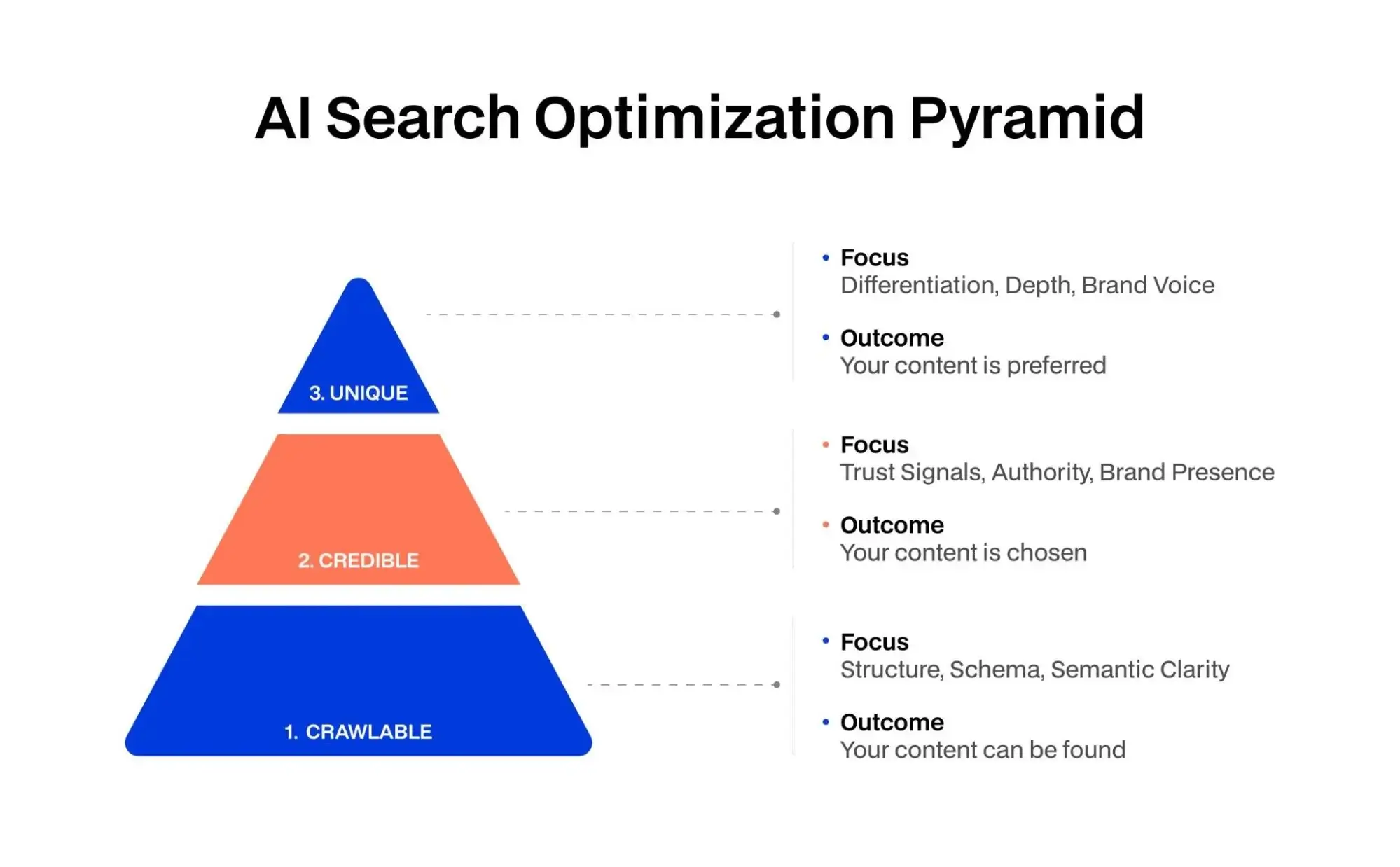
Level 1: Make sure AI can find and understand your content
Before you show up in AI tools and search engines like ChatGPT or Google’s AI Overviews, your website needs to be readable by machines.
Think of it like this: If AI can’t see your content properly, it can’t show it, even if your content is amazing.
So you need to start by getting the basics right. Here’s how:
- Make your website fast and mobile-friendly as slow-loading, clunky pages often get skipped.
- Use a clean structure, including headlines (like H1s and H2s), bullet points, and short paragraphs to help AI know what’s important.
- Answer common questions clearly with one clear idea per paragraph. Avoid walls of text.
- Add “schema markup.” This is extra code that tells AI if your page is a how-to, FAQ, product review, or something else, and it helps a lot.
- Break things into chunks as smaller sections are easier for AI to quote or summarize.
AI tools often pull content from well-structured pages with clear formatting. So if your website is a mess under the hood, you’re likely to be ignored no matter how good your message is.
Level 2: Build trust signals so that AI can trust you
Once AI tools and engines like ChatGPT or Google can read your content, the next question they ask is: “Can I trust this source enough to show it to others?”
That’s where credibility comes in.
Now, to build trust with AI (and your potential customers), here’s what you should do:
- Show who’s behind the content: Add a real author name, photo, short bio, and why they know the topic. No more “written by admin.”
- Be mentioned elsewhere online: Try to get featured on trusted websites like Forbes or Business Insider, news articles, directories like Yelp and Angi, and community forums like Reddit or Quora.
- Keep your brand information consistent: Your business name, location, services, and founder details should match across your website, Google Business Profile, LinkedIn, etc.
- Be known for something: Over time, aim to be “the go-to brand” in your niche, like “Dr. Axe for gut health” or “Notion for productivity.”
AI tools love consistency. And when many sources online point to your business as trustworthy, it is more likely to get picked as the answer.
Level 3: Offer something unique and valuable
Okay, now AI can read your content and it trusts your brand.
But here’s the final test: Are you offering something fresh, useful, and original, or just saying what everyone else says?
You see, if your content sounds like 100 other websites, AI won’t choose you.
Meaning you need to stand out. And here’s how you can do so:
- Share your real-world experience: Talk about what you’ve learned working with customers. Share tips, mistakes, or behind-the-scenes insights.
- Use your own data or process: Have stats from your work? A unique way of doing things? Share it. AI loves specifics.
- Tell stories: Explain how you solved a problem for a client or how your product made a difference. Real stories beat generic fluff.
- Mix up your content: Add helpful images, videos, charts, or tools. These make your content richer and harder to copy.
- Sound like you: Have a clear voice or tone, it can be casual, fun, bold, or quirky. Try to be memorable even without your name attached.
AI wants to give users the “best” answer, not just the average one. So if you’re adding something fresh and helpful, you give AI a reason to choose you over the rest.
Real example: Why Steam and Sauna Experts get noticed by AI
Steam and Sauna Experts are a Florida based e-commerce store that sells sauna equipment. We helped them move from basic SEO to make sure AI tools like ChatGPT also pick up their content.
Now, their blogs and products are showing up in AI answers because their website shares helpful, original information that people (and AI tools) find valuable.
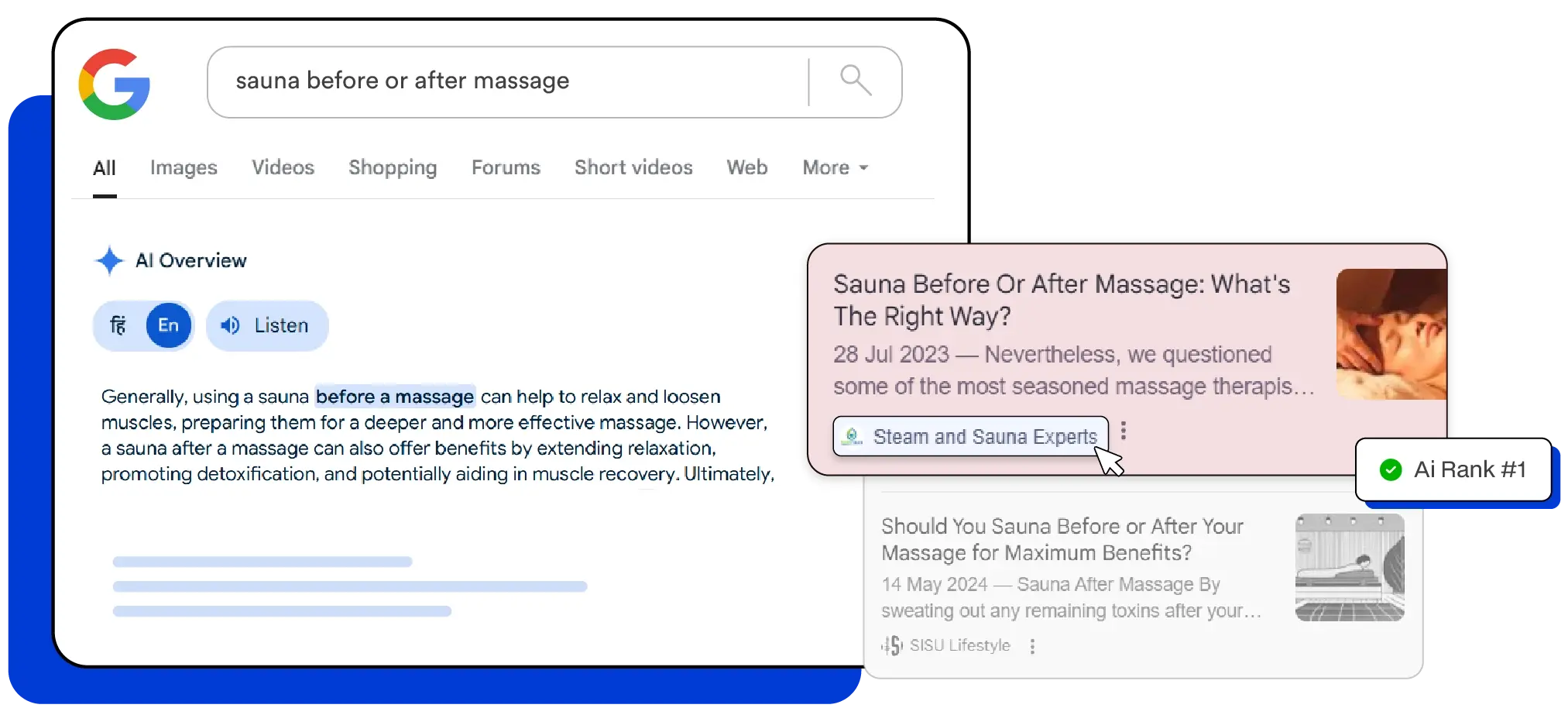
How to do on-page AI search optimization?
On-page optimization means the things you do on your website, like how you write, structure, and organize your content to help it rank.
Now, traditional SEO focused on putting the right keywords in the right places to rank on Google. And it still matters, but it’s not just about keywords and meta tags anymore.
Why?
AI tools like ChatGPT or AI-powered search engines like Google’s AI Overviews don’t just scan your page. They read it, summarize it, and might even quote you directly.
That’s why your content needs to be:
- Easy to understand
- Easy to scan
- Easy to pull answers from
Here’s the goal: Make it simple for AI to find, read, and use your content in its answers.
That’s the new on-page SEO. And it can get your business seen even if no one clicks.
Let’s have a detailed look.
1. Structure your content such that AI can understand it easily
AI tools and search engines like ChatGPT and Google’s AI Overviews don’t read your whole website like a human would.
Instead, they scan your page and pull out small but clear chunks like a short paragraph, a list, or a definition to use in their answers.
That means your job is to make it easy for them to do that. Here’s how:
- Use clear subheadings (like H2 and H3) that match what people are searching for.
- Keep paragraphs short, 2 to 4 lines maximum. Provide one idea per paragraph.
- Use bullet points or numbered lists whenever you can. AI loves these.
- Highlight key facts with simple “Did you know?” or “Here’s the takeaway” boxes.
- Avoid fluff or long-winded writing. Be clear and to the point.
Here’s a comparison:
Not AI-friendly:
“AI tools are changing how people search, and you can improve your visibility using better content formatting, authority signals, schema markup, and proper linking…”
AI-friendly version:
How to Boost AI Search Visibility
- Add FAQ or How-To schema to your site
- Use strong internal links between related pages
- Keep your HTML clean and use proper headers (H1, H2, etc.)
- Write in-depth content that builds topic authority
See the difference?
The second one is easy to quote. That’s exactly what AI engines look for.
2. Focus on what people are really asking
Back in the day, Google mainly looked at keywords. Meaning if someone typed “best pizza oven,” pages with those exact words ranked higher.
But AI tools like ChatGPT don’t work that way. That’s because they try to understand the meaning behind a search, not just the words.
So even if someone phrases it differently, AI knows what they’re really asking.
Here’s what you should do:
- Use your keywords but write like a human, not like a robot.
- Think in questions, not just phrases. Use headers like:
• “What’s the best sauna for small spaces?”
• “Is it safe to use a sauna before bed?” - Cover related topics too. For instance, if you’re talking about saunas, also touch on sleep quality, stress relief, or muscle recovery.
- Answer the follow-up question as AI tools work like a conversation. Include “What’s next?” type answers in your content.
For instance:
We wrote a blog for Steam and Sauna Experts about using saunas at night. And instead of stuffing in keywords like “sauna before bed,” we focused on answering real questions like whether it’s safe, if it helps with sleep, best time to use, etc.
The result?
Their blog got picked up in Google’s AI Overviews and even cited by ChatGPT.
That’s the power of answering real questions.
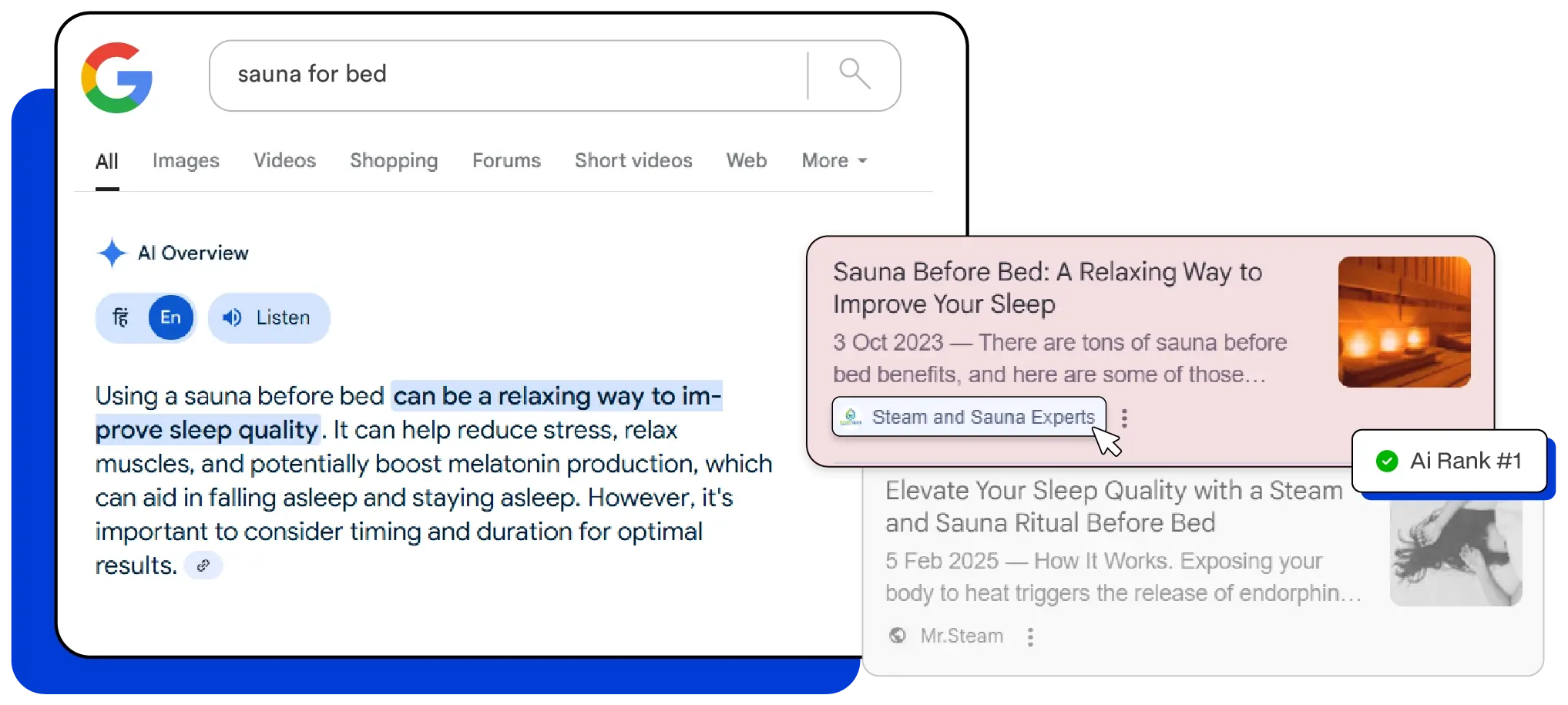
3. Add Schema to help AI understand your content
AI search tools like ChatGPT or Google’s AI Overviews don’t just read your content like humans do, they also scan the behind-the-scenes structure to figure out what your content is about.
That’s where schema (or structured data to put it simply) comes in.
Think of schema like little name tags or labels you stick on different parts of your content to help AI say:
- “Oh! This is a blog post.”
- “Here’s a question and its answer.”
- “This section shows steps like a tutorial!”
- “These are reviews from real customers.”
The most useful schema types you should use include:
- Article or BlogPosting → tells AI it’s a legit piece of content
- FAQPage or QAPage → helps AI spot question-answer blocks
- HowTo → great for step-by-step instructions
- Organization / Person → lets AI know who’s behind the content
- Review → makes customer feedback stand out
- Speakable → perfect for voice assistants like Siri or Alexa
Pro tip: Don’t save FAQs for the bottom. Add question-answer blocks throughout your article.
That way, each answer can stand on its own and be directly quoted by AI.
Simple tweaks like these help your content show up in AI summaries more often without writing anything extra.
4. Optimize your content for AI to read and use
When AI tools like ChatGPT scan your website, they don’t read like a human. They look at the code behind your content, like the structure, layout, and wording, and decide what’s useful.
So, to make your content AI-friendly, here’s what you should do:
- Use clear links: Instead of saying “click here,” write something like “learn more about zero-click search.”
- Avoid vague directions: Skip phrases like “as we said earlier” or “scroll down for more.” AI doesn’t follow your page like a person does.
- Get to the point fast: Don’t start with long introductions. Say what matters right away.
- Add real examples: AI loves real-life use cases and statements that start with “For example…” or “Here’s how it works.”
Remember: You’re not just writing for humans anymore. You’re writing for tools that look for clarity, not cleverness.
The cleaner and simpler your content is, the more likely AI will pick it up and show it to users.
5. Add helpful visuals and tools that AI can see
AI search engines don’t just look at words anymore. They also scan images, videos, charts, and tools on your website, especially if they’re labeled clearly.
Here’s how you can take advantage of that:
- Use custom visuals like charts, graphics, or infographics that explain your topic.
- Always add captions and alt text so AI knows what your visuals are about.
- Include videos and write short summaries or transcripts below them.
- Offer free tools like checklists, calculators, or templates your visitors can actually use.
Pro tip: Some AI tools like Google’s AI Overviews and Perplexity have started pulling visuals into answers. That means not just your words but your images or videos can also be featured.
In short, don’t stop at text. Add useful visuals and tools that make your content stand out and help AI notice you.
6. Link internally and provide context
AI tools don’t just follow links, they read them to understand what the linked page is about. So instead of just linking randomly, add a bit of context.
Here’s what not to do:
Learn more [here].
Here’s what works better:
Want to get your business featured in Google search results? Read our Google Business Profile Optimization Checklist.
The goal is to make your link text clear so that both humans and AI understand why the link is there and what to expect on the other side.
This small tweak helps your pages work together and boosts your chances of being noticed (and cited) by AI tools like ChatGPT and Google’s AI Overviews.
On-page AI search optimization checklist
| Area | Optimized? |
|---|---|
| Clear H1 + nested H2/H3 headers | ✅ |
| Short, focused paragraphs | ✅ |
| Modular answers (lists, Q&A, fact boxes) | ✅ |
| Schema markup (FAQ, Article, Author) | ✅ |
| Clean HTML, no content hidden behind JS | ✅ |
| Contextual internal linking | ✅ |
| Real author with bio and credentials | ✅ |
| Supporting media (charts, videos, tools) | ✅ |
| Alt text and captions for all media | ✅ |
| Anticipated follow-up answers | ✅ |
How to do off-page AI search optimization?
You’ve got your website in good shape. Great!
Now it’s time to tell the world, and AI, that your business is real, trusted, and active across the web.
This is what off-page AI optimization is all about.
Here, you build trust signals across different places online so AI tools like ChatGPT or Google’s AI Overviews recognize and cite you.
Here’s how to do it:
1. Be seen across the web
AI tools don’t just learn from your website, they learn from the entire internet.
So, if you want AI to recognize and trust your business, you need to show up in more places online.
Here’s what I suggest you do:
- Create a LinkedIn profile and post helpful content in your area of expertise.
- Answer questions on Reddit or Quora where your customers hang out.
- Publish helpful blog posts on Medium, Substack, or even industry-specific sites.
- Start a YouTube channel. AI even reads video transcripts.
You want your name or business to pop up in more than one place. That tells AI you’re legit.
2. Show that you know your stuff with E-E-A-T
AI tools don’t just want any answer, they want answers from people who actually know what they’re talking about.
This is where Experience, Expertise, Authority, and Trust, or E-E-A-T, comes in.
Here’s how you can build that:
- Add your name and short bio to blog posts (show you’re a real person).
- Mention your experience or credentials clearly.
- Share real-life stories or case studies from your business.
- Highlight awards, certifications, or badges on your site.
In short: Be a real expert, back it up with real proof, and AI will notice you.
3. Get mentioned on other websites
Imagine this: You own a bakery, and someone writes an article saying,
“The best sourdough in town is from Bella’s Bakery.”
Now, ideally you’d want them to give your website a link on their article. But even if they don’t link to your website, that little shoutout still matters.
Why?
Because AI tools like ChatGPT and Google AI Overviews scan the entire internet. And when they see your business mentioned in multiple places, they start recognizing you as a trusted brand.
Here’s how you can make this happen:
- Writing guest articles for popular blogs in your industry.
- Joining podcasts or webinars.
- Sharing expert tips with journalists via tools like HARO or Qwoted.
- Collaborating with influencers or thought leaders in your niche.
When people talk about you online, it helps you show up in AI-generated answers.
4. Build links that make sense to AI
Getting other websites to mention or link to you helps.
But now, it’s not just about getting a link, it’s about where and how you’re mentioned.
Here’s what you can do:
- Get featured on websites that explain why you’re being mentioned. For instance, a blog saying “We used XYZ Plumbing and they saved us $500” is better than just a name drop.
- Aim for websites that are trusted and stable. For instance, educational, government, or industry-specific sites are great because AI engines prefer them.
- Pick quality over quantity. That’s because one mention on a respected site in your industry is worth way more than hundred shoutouts on low-quality blogs.
- Share real numbers and tools. For instance, a case study with stats or a calculator you created is more likely to be picked up and understood by AI.
5. Share content where AI can see it
AI tools don’t just pull answers from websites, they also scan popular platforms where people share helpful content.
So, to boost your visibility, try showing up in places like:
- LinkedIn articles: Write helpful posts about your industry. These show up in ChatGPT, Google, and Bing results.
- Reddit and Quora: Answer real questions your customers are asking. AI trusts these platforms for real-world insights.
- YouTube: Upload videos explaining your services or answering FAQs. Include good descriptions and transcripts so AI can “read” them.
- GitHub: If you’re in tech or software, sharing code or tools here builds trust.
The key?
Be helpful and clear.
That’s because when AI sees you showing up in all the right places, it’s more likely to quote or recommend your business.
6. Use content formats that AI loves to quote
Want AI tools like ChatGPT to feature your content?
Then create the kind of stuff they like to pull from.
Here’s what works best:
- Simple explanations: Like “What is a cold plunge?” or “Why do saunas help with stress?”
- Data-backed content: Share results from a customer survey or your own stats.
- Step-by-step guides: Show people exactly how to do something, like “How to install a home sauna.”
- Lists: Examples, tips, tools, or templates work great.
- Real case studies: Tell success stories from your customers or projects.
The more clear and useful your content is, the more likely AI is to grab it and show it in answers, giving your business free exposure
Off-page AI search optimization checklist
| Area | Optimized? |
|---|---|
| Profiles on AI-visible platforms (LinkedIn, Reddit, etc.) | ✅ |
| Named authors with bios and credentials | ✅ |
| Brand citations on third-party blogs or news | ✅ |
| Mentions or quotes in expert roundups / PR | ✅ |
| Backlinks from topically relevant sources | ✅ |
| Content published on high-trust UGC platforms | ✅ |
| Inclusion in forums or knowledge-sharing sites | ✅ |
| Social proof across multiple ecosystems | ✅ |
| Digital assets (tools, stats, studies) published | ✅ |
How to track if AI tools and search engines are showing your website?
Unlike Google, AI tools like ChatGPT don’t give you traffic reports or dashboards (not as yet).
But the good news?
There are tools like Ahrefs, SEMrush, and Surfer SEO that help you keep track of when your website or name is mentioned by these AI tools.
And don’t worry if you’re not using those tools yet. You can still check things on your own.
Let me walk you through it:
1. Use AI visibility tools like Ahrefs, SEMrush, and Surfer SEO
Tools like Ahrefs and SEMrushcan tell you if your business is showing up in answers from AI tools like ChatGPT.
These tools act like an online radar. They watch the internet and let you know when your website or business name is being mentioned by these AI tools.
- Ahrefs: Has a feature called Brand Radar that shows when your business is mentioned in AI answers. Also, it lets you see how often you’re mentioned compared to your competitors.
- SEMrush: Offers a simple way to check where and how your business shows up in AI content. It can also give you a general idea of whether the mentions are positive or not.
- Surfer SEO: It tells you when your articles are being picked up by AI tools like ChatGPT or Gemini.
These tools are improving fast and they can give you a real edge if you want to know what AI tools are saying about you.
2. Check manually
You don’t always need fancy tools. Just ask AI tools questions like a real person.
Try this:
- Open Google and search for something like “Best business valuation tips.” Then look at the AI Overview. Do you see your site listed there?
- Go to ChatGPT or Claude and type: “What does [Your Business Name] say about sauna installation?”
- Try Perplexity.ai to ask a question related to your topic. Then check the “Sources” under the answer. Is your site listed?
- On You.com, do the same — and look under the “Sources” tab.
Pro tip: Try searching your name, brand, blog post titles, or unique phrases from your content to catch indirect mentions.
3. Set up brand mention alerts
You can set up alerts to get notified when your name or website is mentioned online.
Here’s how:
- Google Alerts: Set alerts for your brand name, your blog titles, or niche terms.
- Brand24 or Mention.com: These tools send you real-time alerts for brand mentions across websites, social media, and forums.
- Want to go deeper? Ask your tech team to use browser automation tools like Puppeteer or Playwright to monitor Perplexity, Claude, etc.
4. Watch for hidden signs of AI visibility
Even if AI tools don’t link directly to your website, there are still signs that they might be using your content. Here are a few clues to watch for:
- You’re getting links from websites you’ve never heard of, especially ones that often show up in AI search results.
- You see new visitors coming from websites like Perplexity or You.com.
- Your site starts getting visits from very specific search terms. These might come from people who saw your information in an AI answer and searched to learn more.
- You notice your ideas or wording popping up in online comments or forums. This might be AI rephrasing your content.
- You’ve written content especially for AI tools (like blog posts answering common questions), and suddenly you’re getting more visits to those pages.
In short:
| What to Track | Why It Matters |
|---|---|
| Your name or site in AI sources | Direct sign that AI is citing your content |
| Links in Google’s AI Overview | New Page 1 for visibility |
| ChatGPT or Claude paraphrasing your content | Shows AI sees you as an expert |
| Branded questions triggering AI answers | Means you’re top-of-mind in your space |
| Spikes in traffic or mentions | Could signal AI exposure |
AI search visibility can be tricky to measure. But if you track the right clues, you’ll know where your brand stands.
Final words
Search has changed.
When people ask questions online, tools like ChatGPT, Google AI Overviews, and Perplexity are giving them direct answers, that too without showing traditional search results.
So if your business doesn’t show up in those answers, it might not show up at all.
Here’s what you need to do:
- Don’t just optimize for clicks but optimize to be the answer.
- Make your content easy for AI to understand and trust.
- Think beyond Google as AI tools are the new front door to your business.
This isn’t about chasing trends. It’s about showing up where your customers now look first.
Need help showing up in AI answers?
That’s exactly what we do.
At Your Hustler Inc., we help small businesses like yours get noticed in AI search engines.
From fixing your site’s structure to building real online authority, we make sure AI tools trust your content and show it to the world.
Let’s talk and put your business in front of tomorrow’s searchers today.
FAQs about AI search optimization
What is AI search optimization (AIO)?
It’s like SEO, but for tools like ChatGPT and Google’s AI Overview. You structure your content so AI tools can find and show it in their answers.
How do AI tools decide what to show?
They pick content that’s accurate, well-written, easy to understand, and comes from trusted sources.
Is regular SEO still important?
Yes! Good SEO still matters. AIO just adds an extra step to help your content get found by AI tools too.
Can ChatGPT or Perplexity read my website?
Yes, if you let their bots access your site. They scan public pages to find helpful info.
Should I allow AI bots like GPTBot?
If you want your content to show up in ChatGPT answers, yes. You can control what they see in your site settings.





